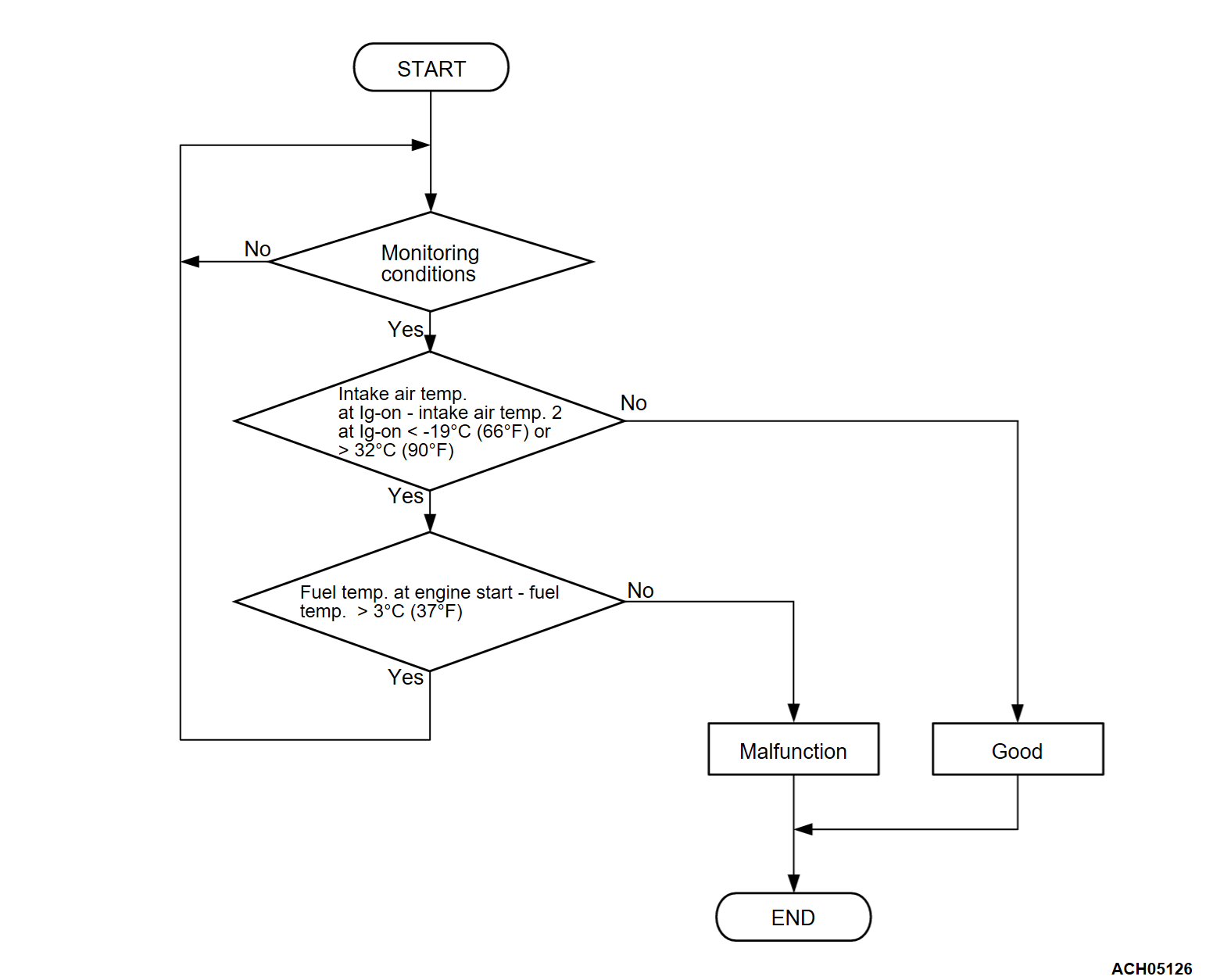DTC P2199: Abnormal Correlation Between Intake Air Temperature Sensor 1 And Sensor 2
CIRCUIT OPERATION
TECHNICAL DESCRIPTION
MONITOR EXECUTION
- Once per driving cycle
MONITOR EXECUTION CONDITIONS (Other monitor and Sensor)
Other Monitor (There is no temporary DTC set in memory for the item monitored below)
- Fuel tank temperature sensor monitor
Sensor (The sensor below is determined to be normal)
- Engine coolant temperature sensor
- Intake air temperature sensor 1
- Intake air temperature sensor 2
Check Conditions
- The engine coolant temperature is higher than 78°C (172°F) engine stop in previous Drive Cycle <Up to 18 Model year>
- The engine coolant temperature is higher than 77°C (171°F) engine stop in previous Drive Cycle <From 19 Model year>
- The engine coolant temperature - fuel tank temperature is between -5°C (-23°F) and 5°C (41°F) when the ignition on.
- Battery positive voltage is higher than 10 volts.
Judgment Criterion
- The intake air temperature sensor 1 output - intake air temperature sensor 2 output is less than -19°C (-2°F) or higher than 32°C (90°F) when the ignition on.
| note |
|
FAIL-SAFE AND BACKUP FUNCTION
- None.
TROUBLESHOOTING HINTS (The most likely causes for this code to be set are:)
- Intake air temperature sensor 1 circuit harness damage, or connector damage.
- Intake air temperature sensor 2 circuit harness damage, or connector damage.
- Intake air temperature sensor 1 failed.
- Intake air temperature sensor 2 failed.
- ECM failed.
DIAGNOSIS
STEP 1. Using scan tool (M.U.T.-IIISE), check data list item 5: Intake Air Temperature Sensor 1.
| caution | To prevent damage to scan tool (M.U.T.-IIISE), always turn the ignition switch to the "LOCK" (OFF) position before connecting or disconnecting scan tool (M.U.T.-IIISE). |
(2) Remove the mass airflow sensor from the air cleaner cover.
(3) Turn the ignition switch to the "ON" position.
(4) Set scan tool (M.U.T.-IIISE) to the data reading mode for item 5, Intake Air Temperature Sensor 1.
(5) Heating the sensor using a hair drier.
- The indicated temperature increases.
note Do not allow it to increase over 80°C (176°F).
(6) Turn the ignition switch to the "LOCK" (OFF) position.
(7) Attach the mass airflow sensor.
Is the sensor operating properly?
STEP 2. Using scan tool (M.U.T.-IIISE), check data list item DE: Intake Air Temperature Sensor 2.
(1) Remove the boost pressure sensor from the charge air cooler outlet air pipe.
(2) Turn the ignition switch to the "ON" position.
(3) Set scan tool (M.U.T.-IIISE) to the data reading mode for item DE, Intake Air Temperature Sensor 2.
(4) Heating the sensor using a hair drier.
- The indicated temperature increases.
note Do not allow it to increase over 80°C (176°F).
(5) Turn the ignition switch to the "LOCK" (OFF) position.
(6) Attach the boost pressure sensor.
Is the sensor operating properly?
STEP 3. Check the intake air temperature sensor 2.
STEP 4. Check the continuity at boost pressure sensor harness side connector.
(1) Disconnect the boost pressure sensor connector and measure at the harness side.
(2) Check for the continuity between terminal E line and ground.
- Continuity (2 ohms or less)
Does continuity exist?
STEP 5. Check of harness damage in E line between boost pressure sensor connector and ECM connector.
Is the harness wire in good condition?
STEP 6. Check of harness damage in UATS line between boost pressure sensor connector and ECM connector.
Is the harness wire in good condition?
STEP 7. Using scan tool (M.U.T.-IIISE), check data list item DE: Intake Air Temperature Sensor 2.
(1) Turn the ignition switch to the "ON" position.
(2) Set scan tool (M.U.T.-IIISE) to the data reading mode for item DE, Intake Air Temperature Sensor 2.
- The intake air temperature and temperature shown with the scan tool should approximately match.
(3) Turn the ignition switch to the "LOCK" (OFF) position.
Is the sensor operating properly?
![[Previous]](../../../buttons/fprev.png)
![[Next]](../../../buttons/fnext.png)



